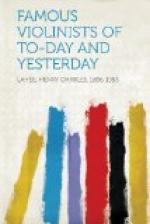This happened on his eighth birthday, and the event marked an epoch in his life, for he was elected an active member of the Tuesday club, and began to take lessons regularly of the convivial Paulsen.
There is a pathetic story of how Ole induced his father to buy a new violin for him, and, unable to restrain his desire to play it, he got up in the night, opened the case, and touched the strings. This furtive touch merely served to whet his appetite, and he tried the bow. Then he began to play very softly; then, carried away with enthusiasm, he played louder and louder, until suddenly he felt the sharp sting of his father’s whip across his shoulders, and the little violin fell to the floor and was broken.
From 1819 to 1822 Ole Bull received no violin instruction, for Paulsen had left Bergen without explanation, though it has been hinted that Ole Bull had outgrown him, and on that account he thought it wise to depart.
In 1822 a Swedish violinist came to Bergen, and Ole took lessons of him. His name was Lundholm, and he was a pupil of Baillot. Lundholm was very strict and would admit of no departure from established rules. He quite failed to make the boy hold his instrument according to the accepted method, but his custom of making his pupil stand upright, with his head and back against the wall while playing, no doubt gave to him that repose and grace of bearing which was so noticeable in later years. Lundholm was, however, quite unable to control his precocious pupil and a coolness soon sprung up between them, which appears to have culminated in the following incident.
On a Tuesday evening, at one of the regular meetings, Lundholm played Baillot’s “Caprizzi,” but Ole Bull was much disappointed at the pedantic, phlegmatic manner in which he rendered the passionate phrases. When the company went to supper Ole found on the leader’s music-rack a concerto of Spohr’s, and began to try it over. Carried away with the music, he forgot himself, and was discovered by Lundholm on his return, and scolded for his presumption.
“What impudence!” said the violinist. “Perhaps you think you could play this at sight, boy?” “Yes,” was the reply, “I think I could.” His remark was heard by the rest of the company, who were now returning, and they all insisted that he should try it. He played the allegro, and all applauded except Lundholm, who looked angry. “You think you can play anything,” he said, and, taking a caprice of Paganini’s from the stand, he added, “Try this.” It happened that this caprice was a favourite of the young violinist, who had learned it by heart. He therefore played it in fine style, and received the hearty applause of the little audience. Lundholm, however, instead of raving, was more polite and kind than he had ever been before, and told Ole that with practice he might hope to equal him (Lundholm) some day.
Years afterwards, when Ole Bull was making a concert tour through Norway, and was travelling in a sleigh over the snow-covered ground, he met another sleigh coming from the opposite direction, of which the occupant recognised him, and made signs to him to stop. It was Lundholm. “Well,” shouted he, “now that you are a famous violinist, remember that when I heard you play Paganini I predicted that your career would be a remarkable one.”




